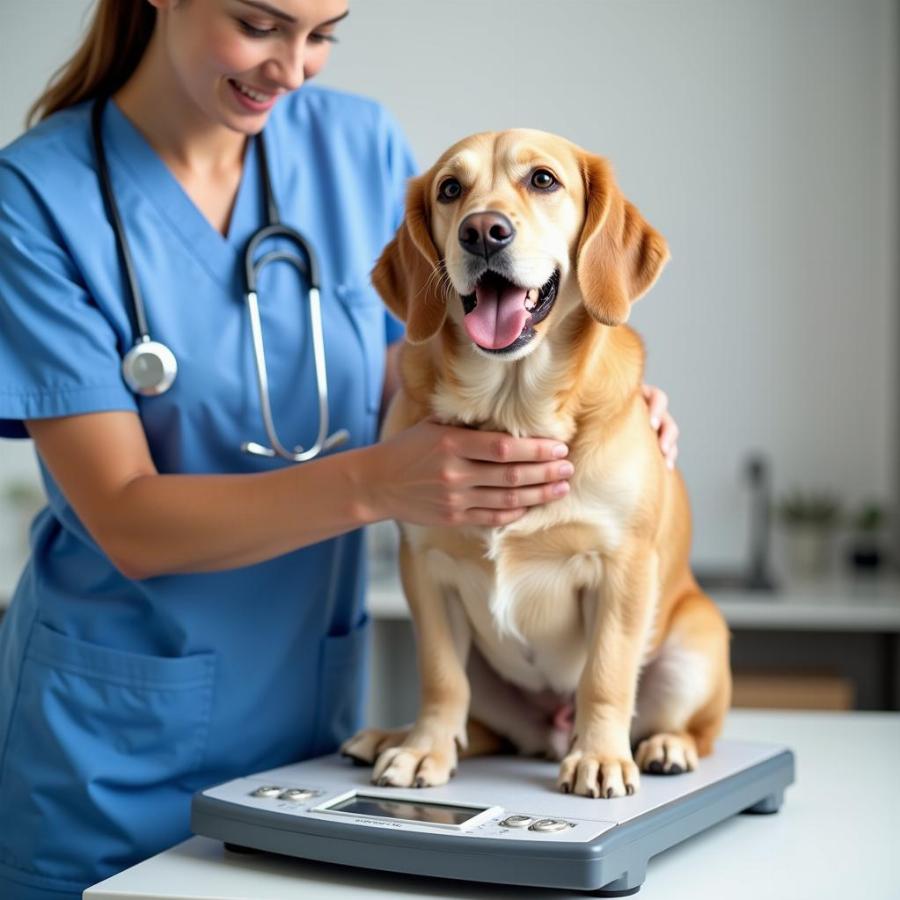Is your furry friend looking a little too thin? Weight gain for dogs is about more than just extra treats; it’s about understanding their needs and providing the right nutrition to help them thrive. This article will guide you through the process of safely and effectively helping your dog gain weight.
Recognizing When Your Dog Needs to Gain Weight
Before you start adding calories to your dog’s diet, it’s crucial to determine if they actually need to gain weight. Dogs come in all shapes and sizes, and what’s considered “thin” for one breed might be perfectly healthy for another.
Here are some signs that your dog might need to put on some pounds:
- Visible ribs, spine, or pelvic bones: You should be able to feel your dog’s ribs easily, but they shouldn’t be prominently visible.
- Lack of a defined waist: Looking down at your dog from above, you should see a noticeable tuck in at the waist behind the rib cage.
- Loss of muscle mass: This might be noticeable around the shoulders and hindquarters.
- Low energy levels: If your dog seems lethargic or uninterested in their usual activities, it could be a sign of being underweight.
It’s important to note that sudden weight loss can be a sign of an underlying health condition. If your dog has lost weight rapidly or is exhibiting other symptoms like vomiting, diarrhea, or changes in appetite, consult your veterinarian immediately.
Common Causes of Weight Loss in Dogs
There are many reasons why a dog might be underweight. Understanding the cause is essential for determining the best course of action to help your dog regain their healthy weight. Here are some common culprits:
- Insufficient Food Intake: This could be due to a lack of appetite, competition for food from other pets, or simply not being fed enough for their age, breed, and activity level.
- Malabsorption: Certain medical conditions, such as inflammatory bowel disease or exocrine pancreatic insufficiency, can interfere with a dog’s ability to absorb nutrients from food.
- Parasites: Intestinal parasites like roundworms, hookworms, and tapeworms can steal nutrients from your dog’s digestive system, leading to weight loss.
- Stress or Anxiety: Just like humans, dogs can experience stress and anxiety, which can lead to a decreased appetite and weight loss.
- Medical Conditions: A variety of medical conditions, including cancer, liver disease, and kidney disease, can cause weight loss in dogs.
Creating a Weight Gain Plan for Your Dog
If you suspect your dog needs to gain weight, it’s essential to consult with your veterinarian. They can rule out any underlying medical conditions and help you develop a safe and effective weight gain plan tailored to your dog’s individual needs.
1. Dietary Changes for Healthy Weight Gain
The cornerstone of any successful weight gain plan for dogs is a nutritious and calorie-dense diet. Here’s what to consider:
- High-Quality Dog Food: Choose a high-quality dog food that is rich in protein, healthy fats, and essential nutrients. Look for foods specifically formulated for weight gain or for puppies, as they often have a higher calorie content.
- Increased Feeding Frequency: Instead of feeding your dog one or two large meals a day, try increasing the frequency to three or four smaller meals. This can help improve digestion and nutrient absorption.
- Healthy Extras: You can supplement your dog’s regular meals with healthy, calorie-rich extras. Some good options include cooked lean meats (chicken, turkey, fish), plain cooked rice, sweet potato, canned pumpkin (not pie filling), and eggs.
2. Monitoring Progress and Adjusting as Needed
Once you’ve implemented a weight gain plan, it’s important to monitor your dog’s progress closely. Weigh your dog weekly or bi-weekly and keep track of their weight in a journal.
- Gradual Weight Gain: Aim for a gradual and healthy weight gain of 1-2% of their body weight per week.
- Adjust as Needed: If you’re not seeing results, don’t be afraid to adjust your dog’s food amount or feeding frequency. Consult with your veterinarian for guidance.
 Dog Being Weighed at the Vet
Dog Being Weighed at the Vet
Foods to Avoid When Helping Your Dog Gain Weight
While it’s tempting to give your dog table scraps or unhealthy treats to help them gain weight, it’s crucial to avoid certain foods that can be harmful to their health:
- High-Fat Foods: Excessive fat can lead to pancreatitis, a serious and potentially life-threatening condition.
- Cooked Bones: Cooked bones can splinter and cause serious internal injuries.
- Grapes and Raisins: These can cause kidney failure in dogs.
- Onions and Garlic: These can damage red blood cells and lead to anemia.
- Chocolate: Chocolate contains theobromine, which is toxic to dogs.
Conclusion
Helping your dog achieve a healthy weight is an act of love and responsibility. By understanding their dietary needs, recognizing potential problems, and working closely with your veterinarian, you can help your furry companion live a longer, healthier, and happier life.
For tailored advice and guidance on your dog’s weight management, reach out to Beaut Dogs at [email protected]. We’re here to help you navigate the world of dog care with confidence and provide the best possible care for your canine companion.
Beaut Dogs is your go-to resource for all things dog-related, offering reliable and insightful information on the fascinating world of dogs. From breed specifics to care guides, we’re here to support you in providing the best possible care for your beloved pet.